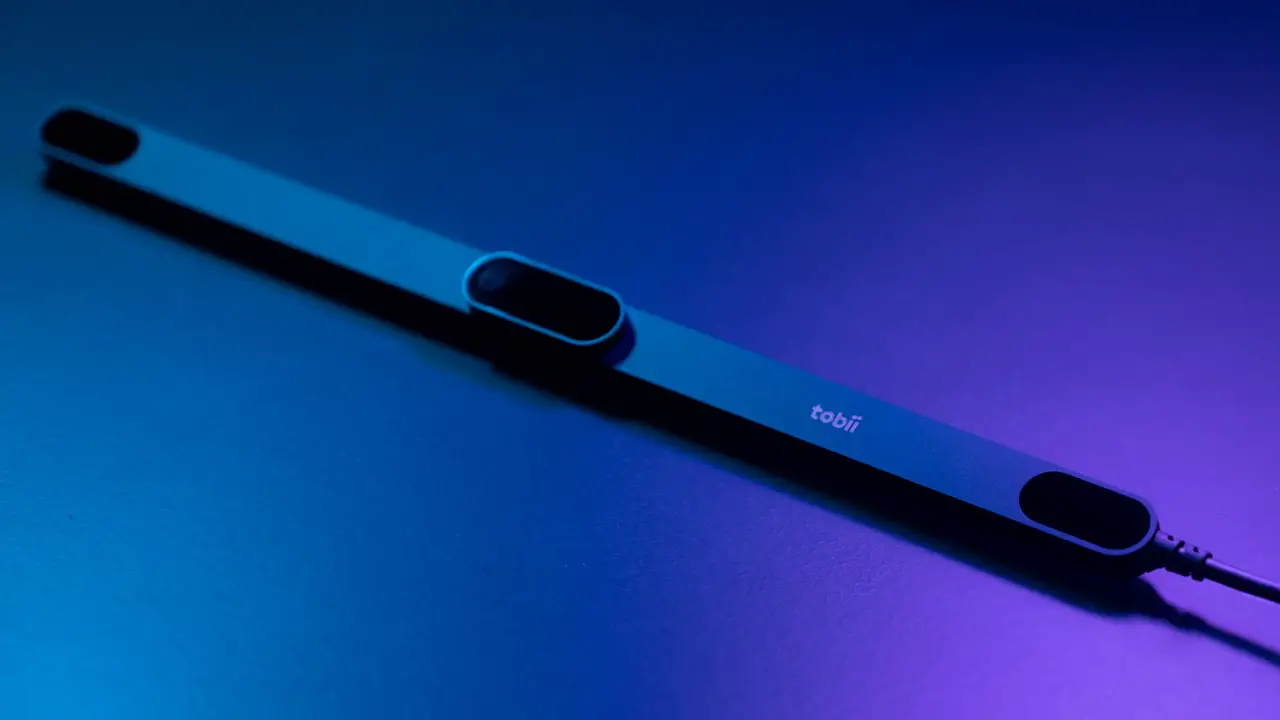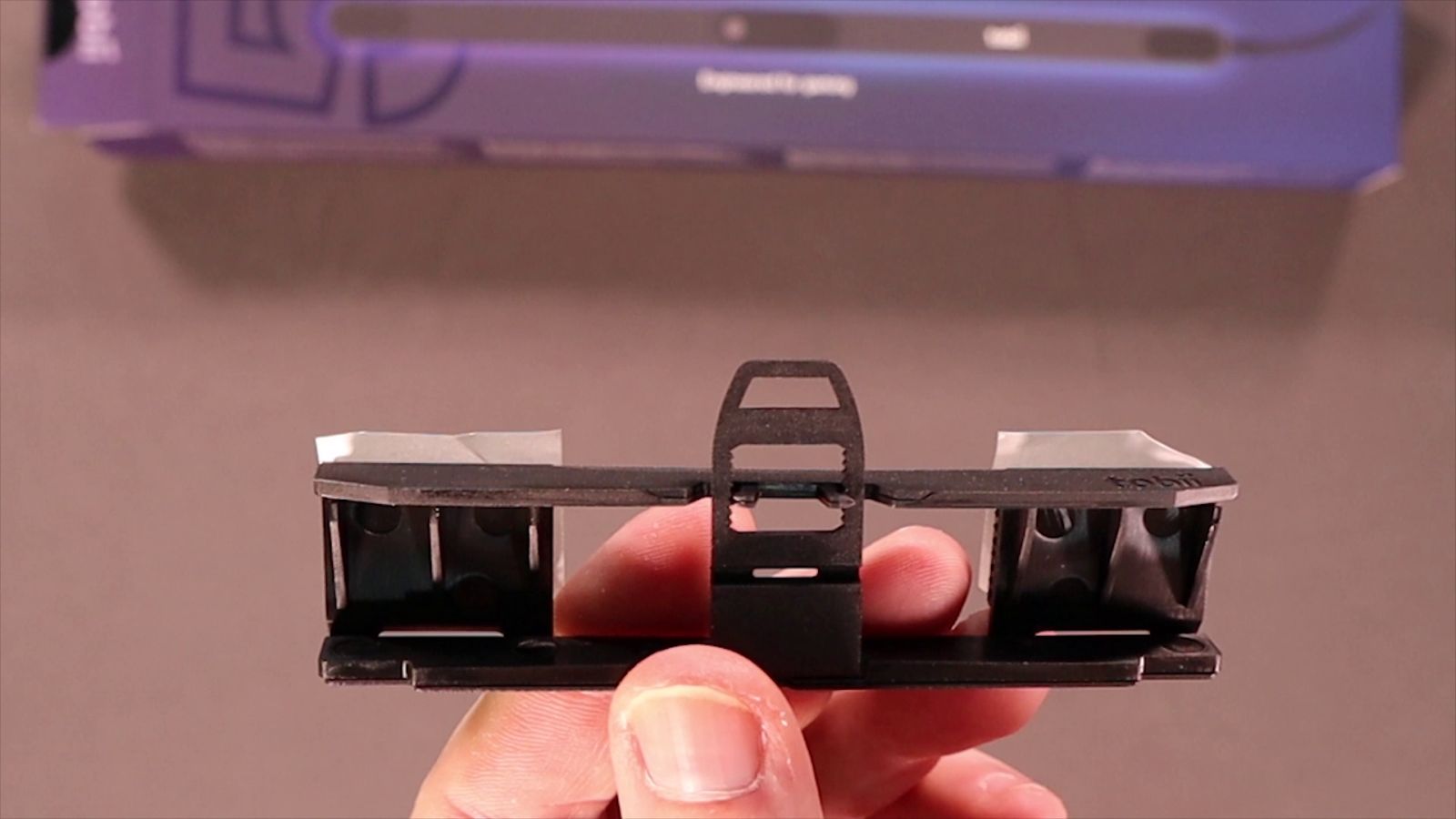
We’ve been a big fan of Tobii’s eye tracking technology for a long time. I reviewed the Tobii EyeX eye tracker back in 2016 (my review), Kay went eyes-on with the 3rd generation of their system it in June of 2017 at E3 (her thoughts), and Devo checked out the 4C in December of 2019 (his review). Now Tobii is preparing for their next major uplift — the Tobii Eye Tracker 5.
The strength of the Tobii Eye Tracker 5 aligns with three pillars — streaming, gaming, and training. Depending on your use case, not all three of those will matter to you. Before we get into the new tracker, I want to take a moment and talk about the HTC Vive Pro Eye — a speciality VR headset with Tobii eye tracking baked right into the hardware platform. With the Vive Pro Eye, the dev I was talking to was able to directly translate my eye movements to my in-game avatar, but more importantly it allowed them to use something called “Foveated Rendering”. Foveated Rendering, put simply, is when the game takes into account where your eyes are looking, reducing the rendering level of detail on objects you aren’t currently focused on. Obviously that’s not something that is built into the Tobii Eye Tracker 5, but it does give you an idea of the potential of eye tracking. With that said, let’s see what’s new with this iteration of the hardware.
The first and likely most important upgrade to the Tobii Eye Tracker 5 is a brand new optical sensor. One of the challenges I’ve seen with the previous models is that you had to be pretty close to the screen to get accurate tracking. Screen sizes getting larger and wider only exacerbates the problem. I use a pair of 27” monitors, and I anticipated that this might be a challenge. Turns out, the device supports not only larger format monitors, but also ultrawide and curved monitors as well (with an included optional mount). Specifically, the device can handle anything up to a 27” monitor with 16:9 aspect ratio or a 30” with a 21:9 aspect ratio. More importantly, they’ve also improved the viewing distance. Working anywhere from 17.7” to 38.5” away, you no longer have to lean into your monitor to make this all work. You can’t center it in the middle of two monitors, but that’s to be expected.
Despite the smaller size of the Eye Tracker 5 (compared to the 4C), the Tobii team made a real improvement in the viewing angles of this iteration. The Eye Tracker 4C had a viewing angle of 38 x 29 degrees, so you were always reaching the upper end of the tracking sensor’s height abilities as you looked at the top and bottom of the screen. The Eye Tracker 5 now sports a 40 x 40 degree field of view. In practice I can honestly say that this new tracker never lost tracking on my eyes. Reinstalling my previous versions I noticed the improvement. Sometimes you don’t know how much better something is until you do a side-by-side comparison.
What games work with Tobii? The list is up to 155 and growing at the time of this writing. You don’t have to go chase down individual games — the Tobii Game Hub software will detect and auto-integrate with anything you have installed. For those games that aren’t officially supported, there is a more generic overlay (something I wished for in my initial review) that will show the eye tracking bubble over anything you are doing — desktop included. It makes the officially supported list less important.
Beyond traditional gaming, and moving to the competitive streaming side, there is direct integration with the Twitch platform for Tobii-enabled devices. I say it that way as there are now several monitors with the tech baked right in. Linking it up to the Eye Tracker 5 was a breeze as it autodetected and required zero configuration. Your audience can see where your eyes are focusing, letting them harass you roundly when you miss that epic shot because you were looking the wrong direction. If they aren’t into it, your audience can turn it off for their screen, while others can keep it on for theirs if they choose. They can also change the shape and color if the default blue is distracting. If you don’t want to just see in real time where the person streaming is looking, you can also enable heatmaps to see where they look most. You can also invert the brightness, muting the game into the background slightly while showing the Tobii ghost more clearly. If you think you might be getting killed a lot in shooters, you might check this out — you could have tunnel vision in your games and not know it. I can’t guarantee that it’ll improve your skills, but it might make you more aware.
One of the little things that matter about the 4C versus the 5 is the body construction. The plastic body of the 4C was bulky and the way it adhered to the monitor was problematic. The team moved to a machined aluminum body construction and put it on a bit of a diet — the 4C was 13.1” in width, whereas the 5 is only 11.2”. This helped lock it down nicely thanks to the new mounting system and some improved adhesive. The magnet on this device is insanely strong, so the adhesive has to be equally as solid.
It seems like such a minor thing now, but in 2016, the Tobii EyeX used a relatively new connection type called USB 3.0. An included Mini B type cable was needed to make it all work. The team continued to bang away at this interface, despite every modern PC having USB 3.0 ports aplenty. As a result, the Tobii Eye Tracker 5 only requires a USB 2.0 port, meaning it uses much less USB bandwidth overhead. It’s unlikely to make a world of difference unless you have entirely too many USB devices connected, but it does show just how committed to refinement the Tobii team really is.
There was a challenge with previous models of Eye Tracker where the mounts would only work on a flat surface. That challenge is still present, but Tobii has seen fit to include a mount bracket to solve it. This bracket allows you to mount to a curved monitor like Sceptre, AOC, and Samsung models, attaching underneath the monitor, with the mounting plate attaching to the front of said bracket. The front of my Dell monitors had the Dell logo dead center, so I found myself using the bracket after it fell off a few times despite the better adhesive because it couldn’t sit flush. It’s a simple but effective solution to a long-standing issue with the Tobii trackers.
Like previous Eye Tracker models, the 5 supports Windows Hello. If you are unfamiliar, Windows Hello lets you sign into your machine using facial recognition. The previous models would use infrared to scan your face, measuring things like the distance between your eyes, your jawline, and other facial measurements. The improved sensor on the 5 makes it Windows Hello 4.x compatible, meaning that it has a better understanding of the biometrics of your face (aka FIDO, or Fast Identity Online), looking at your face, but also even scanning your iris. It does this with the infrared sensors on both ends of the bar, but also adds RGB into the mix. Infrared looks at your face via the infrared spectrum which is less influenced by lighting conditions. RGB reduces false positives by also sampling the color spectrum, giving a second reference image to analyze. In practice, I found that the unlocking procedure was simply faster and more reliable.
All of these upgrades are great on paper, but where it matters is when you play games. In Assassin’s Creed Odyssey you can turn the camera slightly by moving your head in the appropriate direction, but eye tracking lets you change targets by simply looking at them. When flying Ikaros to scout an area, you can control the bird almost entirely without using a controller. He’ll turn with your head movements, sighting in on your targets — a really new and interesting way to scout an area that instantly reminded me of the Ubisoft VR title, Eagle Flight. In Tom Clancy’s The Division 2 the Tobii Eye Tracker let’s you turn your head slightly to look left, right, up, or down. This is handy when you are doing a bully-run down the street and need to glance briefly in a direction without losing momentum. You can essentially “glance” in a direction with a slight head turn, but more subtle eye movements will translate to equally subtle camera movements. In a game like American Truck Simulator you can turn your head to look out the windows of your big rig, which is handy as the game is a solid simulation of what it’s like to pilot 80,000lbs of truck across America’s heartlands. If trucking is your thing, but you’d rather set your sights on the stars, then you’ll be happy to know that eye trackers are practically made for flight.
Elite Dangerous is one of the best uses of headtracking, and it’s baked directly into the game. With no configuration whatsoever, your head movements are directly translated into the game. This is handy during dogfights, docking, and everything in between, creating a layer of immersion that pairs nicely with a HOTAS setup. If VR makes you sick, this is the next best thing. Star Citizen, the perpetually-in-development money soak that it is, doesn’t officially support the Tobii Eye Tracker, but with some creative hacks and middleware it can pull off the same tricks as Elite Dangerous.
Looking forward, there is a big title coming up that I hope will officially support the Tobii Eye Tracker 5, and it’s very likely that if you are reading this review it’s on your must-have list. I’m talking about Microsoft Flight Simulator. The 2006 title, Flight Simulator X, supported it by allowing you to aim the camera with your head movements, but the enhanced hardware tucked into the Eye Tracker 5, and the greater fidelity of the sensor should provide new ways to play, but we’ll have to wait for the launch on August 18th to see how fast we see official support.
It’s very clear that there is a whole lot of tech present in the Tobii Eye Tracker 5, and all of these enhancements come at a premium. This Eye Tracker retails for $229 — what looks like a hefty increase over the 4C’s launch price of $169. In fact, this is a direct result of the completely pointless trade war with China which caused a 30% tariff to be placed on goods like the Tobii Eye Tracker. It happened to the 4C, and that price increase is baked into the launch price of the 5. It’s unfair to consumers, but I can’t fault Tobii on this — we did it to ourselves.
Tobii Eye Tracker 5
Great
The Tobii Eye Tracker 5 isn’t just an iteration of the 4C, but a huge leap forward. Better detection, better Windows Hello integration, better support for wide or curved monitors, better adhesion, better mounting, better imaging...everything is just better across the board. Whether you are taking to the virtual skies, or fragging your virtual foes, the Tobii Eye Tracker 5 will give you a whole new way to augment your gameplay.
Pros
- Improved mounting solution is included
- Now works on larger and curved screens
- Far better eye and head movement recognition
- Makes simulators even more immersive
- Direct streaming integration is fun
Cons
- Limited functionality for ultrawide monitors
- Many games offer only subtle camera movement

